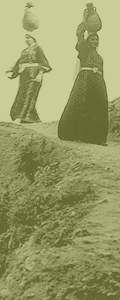- The West Bank and Gaza suffer from a chronic water shortage, preventing sustained economic growth and damaging the environment and health of Palestinians. Further losses are caused by old, deteriorated infrastructure.
- Palestinians have a very low water consumption rate - generally using about half of internationally recommended daily amount of water for consumption, hygiene, and cleaning needs. One ten minute shower in the U.S. equals a day's water consumption for an average Palestinian.
- Hundreds of rural villages across the West Bank have no piped water, and hundreds more have it only in the winter. Residents typically use less than 30 liters per capita per day because of the high costs of water delivered by truck. Fewer and fewer families can afford basic water supplies.
- Water quality is not being tested in villages, and much of the water being used is untreated, largely because closures and curfews prevent of access to chlorine and safe water sources. About two-thirds of drinking water in rural households is contaminated with bacteria.
- Palestinian ground water supplies have increasingly become polluted as a result of agricultural chemicals, inadequate sewage treatment and over-pumping of wells. Untreated sewage is dumped in valleys and the Mediterranean Sea, decreasing the quality of the already inadequate groundwater supply, and polluting the soil, sea, and coastline.
USAID RespondsUSAID/WBG has remained steadfast in implementing a multi-year program that combines the rapid development of new water sources, improved systems for water distribution and management, and wastewater treatment. Despite the challenges posed by the Intifada (including shortages of critical building materials, limited access to the work site, and physical danger to workers), well drilling, pipeline construction, and delivery of essential water infrastructure continues with impressive results. USAID, through its $42 million contracts with CH2M HILL and Contrack International, is constructing one well near Nablus and four wells, two pump stations, and 17 kilometers of pipeline in the Bethlehem/Hebron region that will add new sources of water. In the Hebron region, new transmission lines will deliver this water to more than 25 villages. An aquifer modeling tool, design by CH2, will enable the Palestinian Water Authority (PWA) to manage these resources efficiently. In Hebron, the interests of Palestinians and Israelis have merged and led to the design of the Hebron Wastewater Treatment Plant. This $50 million USAID project will address the Israeli's concerns to protect the shared aquifer and eliminate stream pollutants in the northern Negev. For the Palestinians, the plant will protect public health, clean-up the environment, and develop agricultural uses for water that is now wasted. In the West Bank, the heightened security situation and economic crisis have decreased access to water for the people in rural villages. Through USAID's Village Water and Sanitation program, a $9 million activity implemented by CDM's Environmental Health Project (EHP), construction of new water systems for under-served villages west of Hebron will begin later this year, and construction near Nablus will begin in 2004. In the meantime, USAID is providing water via tanker trucks to severely affected areas. The Mission's $20 million Coastal Aquifer Management Program (CAMP), implemented by Metcalf & Eddy, supports activities to improve the management of Gaza's water system. A computerized model of the coastal aquifer highlights the dangers of over-pumping and points the way to sustainable water management. Desalination of seawater will be an essential element of Gaza's future water needs, and USAID will provide a plant to produce 60,000 cubic meters of water a day, equivalent to 40% of Gaza's current municipal supply. Other important achievements of CAMP include a monitoring system to help prevent over-pumping, rehabilitation of existing wells to improve efficiency and water quality, and re-use of treated wastewater through aquifer recharge. The Emergency Water Operations Center, implemented by the EHP, provides immediate emergency response to damaged water systems in the West Bank and Gaza, including well repair, pipeline repair, and new water infrastructure. Municipalities and the West Bank Water Department are being provided pipes, pumps, generators, and related materials to replace facilities damaged during "Operation Defensive Shield." Results- USAID wells and pipelines have nearly doubled the amount of water available for about 400,000 residents of Bethlehem and Hebron in the West Bank.
- USAID expanded a Jenin area well and provided for piped-in and cleaner drinking water for 11 villages in the Jenin area of the northern West Bank. Previously, the 40,000 people living in these villages had to rely on expensive deliveries of poor-quality water by truck.
- In early 2001, USAID financed a water distribution system for the Ein Sultan refugee camp near Jericho, bringing reliable running water to the 3,000 refugees for the first time ever.
- In Gaza, USAID built wastewater treatment capacity and sewers for about 400,000 Palestinians in Gaza City.
USAID upgraded the existing treatment plant and increased its capacity to handle the city's wastes. The water treated in the plant is of high enough quality to recharge the shrinking Gaza water table.
|
 USAID WEST BANK & GAZA
USAID WEST BANK & GAZA


